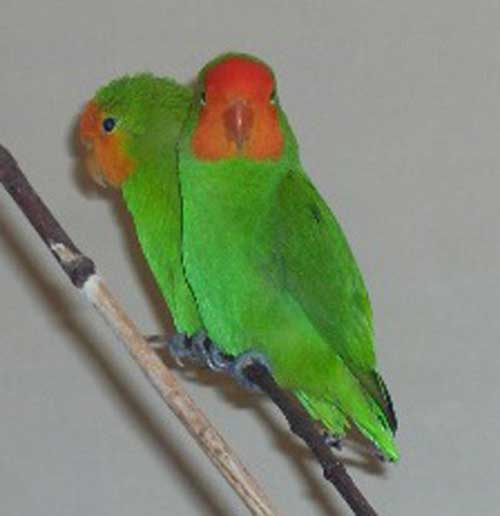
Agapornis pullarius (*)
Superregnum: Eukaryota
Cladus: Unikonta
Cladus: Opisthokonta
Cladus: Holozoa
Regnum: Animalia
Subregnum: Eumetazoa
Cladus: Bilateria
Cladus: Nephrozoa
Superphylum: Deuterostomia
Phylum: Chordata
Subphylum: Vertebrata
Infraphylum: Gnathostomata
Megaclassis: Osteichthyes
Cladus: Sarcopterygii
Cladus: Rhipidistia
Cladus: Tetrapodomorpha
Cladus: Eotetrapodiformes
Cladus: Elpistostegalia
Superclassis: Tetrapoda
Cladus: Reptiliomorpha
Cladus: Amniota
Classis: Reptilia
Cladus: Eureptilia
Cladus: Romeriida
Subclassis: Diapsida
Cladus: Sauria
Infraclassis: Archosauromorpha
Cladus: Crurotarsi
Divisio: Archosauria
Cladus: Avemetatarsalia
Cladus: Ornithodira
Subtaxon: Dinosauromorpha
Cladus: Dinosauriformes
Cladus: Dracohors
Cladus: Dinosauria
Ordo: Saurischia
Cladus: Eusaurischia
Subordo: Theropoda
Cladus: Neotheropoda
Cladus: Averostra
Cladus: Tetanurae
Cladus: Avetheropoda
Cladus: Coelurosauria
Cladus: Tyrannoraptora
Cladus: Maniraptoromorpha
Cladus: Maniraptoriformes
Cladus: Maniraptora
Cladus: Pennaraptora
Cladus: Paraves
Cladus: Eumaniraptora
Cladus: Avialae
Infraclassis: Aves
Cladus: Euavialae
Cladus: Avebrevicauda
Cladus: Pygostylia
Cladus: Ornithothoraces
Cladus: Ornithuromorpha
Cladus: Carinatae
Parvclassis: Neornithes
Cohors: Neognathae
Cladus: Neoaves
Cladus: Telluraves
Cladus: Australaves
Ordo: Psittaciformes
Familia: Psittaculidae
Subfamilia: Agapornithinae
Genus: Agapornis
Species: Agapornis pullarius
Name
Agapornis pullarius (Linnaeus, 1758)
Original combination: Psittacus pullarius
References
Linnaeus, C. 1758. Systema Naturae per regna tria naturæ, secundum classes, ordines, genera, species, cum characteribus, differentiis, synonymis, locis, Tomus I. Editio decima, reformata. Holmiæ: impensis direct. Laurentii Salvii. i–ii, 1–824 pp DOI: 10.5962/bhl.title.542: 102–103. Reference page.
Vernacular names
العربية: ببغاء ذو وجه أحمر
català: Agapornis cara-roig
Deutsch: Orangeköpfchen
English: Red-headed Lovebird
español: Inseparable carirrojo
فارسی: طوطی برزیلی صورت قرمز
suomi: Savannikaijanen
français: Inséparable à tête rouge
italiano: Inseparabile testarossa
Bahasa Melayu: Burung Cinta Kepala Merah
Nederlands: Roodmaskeragapornis
norsk: Rødmasket dvergpapegøye
پنجابی: لالسرا متر پنچھی
русский: Краснолицый неразлучник
svenska: Orangebröstad dvärgpapegoja
తెలుగు: ఎర్ర తల లవ్ బర్డ్
中文(简体): 红脸牡丹鹦鹉
The red-headed lovebird (Agapornis pullarius) also known as the red-faced lovebird is a member of the genus Agapornis, a group commonly known as lovebirds. Like other lovebirds it is native to Africa.
Taxonomy
The red-headed lovebird was formally described in 1758 by the Swedish naturalist Carl Linnaeus in the tenth edition of his Systema Naturae. He placed it with all the other parrots in the genus Psittacus and coined the binomial name Psittacus pullarius.[2] The type locality is Ghana.[3] The red-headed lovebird is now one of nine species placed in the genus Agapornis that was introduced in 1836 by the English naturalist Prideaux John Selby.[4][5] The genus name combines the Ancient Greek αγάπη agape meaning "love" and όρνις ornis meaning "bird". The specific epithet pullarius is from Latin and means "of young birds" (pullus means "chick").[6]
Two subspecies are recognised:[5]
A. p. pullarius (Linnaeus, 1758) – Guinea and Sierra Leone to Sudan, DR Congo and Angola
A. p. ugandae Neumann, 1908 – west Ethiopia to east DR Congo and northwest Tanzania
Description
The red-headed lovebird is a 15 cm (6 inches) long, mostly green parrot. It has a well demarcated red area on its head extending from the top of the beak, over the forehead to mid-crown, and extending to the left and right up to the eyelid margins. It has grey feet. The underside of the wings is a lighter green. The female has orange head colouring, which is less well demarcated than the male's red head. The adult male has a red beak while the female's is a paler red.[7]
Distribution and habitat
It has a patchy distribution across the African tropical rainforest.
Breeding
It makes its nest in a termites nest usually in a tree or sometimes on the ground. To make a nest the female digs a tunnel up to a length of 30 cm (12 in) in the termites nest in a colony with other lovebirds.[7]
Aviculture
It is difficult to breed in captivity because it has to burrow to make its nest and the nest chamber needs to be heated to about 27 °C (81 °F); however, they can be induced to burrow into cork to build a nest. It is a very nervous species.[7]
References
BirdLife International (2016). "Agapornis pullarius". IUCN Red List of Threatened Species. 2016: e.T22685330A93068275. doi:10.2305/IUCN.UK.2016-3.RLTS.T22685330A93068275.en. Retrieved 12 November 2021.
Linnaeus, Carl (1758). Systema Naturae per regna tria naturae, secundum classes, ordines, genera, species, cum characteribus, differentiis, synonymis, locis (in Latin). Vol. 1 (10th ed.). Holmiae (Stockholm): Laurentii Salvii. p. 102.
Peters, James Lee, ed. (1937). Check-List of Birds of the World. Vol. 3. Cambridge, Massachusetts: Harvard University Press. p. 254.
Selby, Prideaux John (1836). The Natural History of Parrots. The Naturalist's Library. Volume 6. Edinburgh: W.H. Lizards. p. 118.
Gill, Frank; Donsker, David; Rasmussen, Pamela, eds. (January 2022). "Parrots, cockatoos". IOC World Bird List Version 12.1. International Ornithologists' Union. Retrieved 21 March 2022.
Jobling, James A. (2010). The Helm Dictionary of Scientific Bird Names. London: Christopher Helm. pp. 36, 324. ISBN 978-1-4081-2501-4.
Le Breton, Kenny (1992). Lovebirds...getting started. USA: T.F.H. Publications. pp. 85–88. ISBN 0-86622-411-4.
Retrieved from "http://en.wikipedia.org/"
All text is available under the terms of the GNU Free Documentation License

